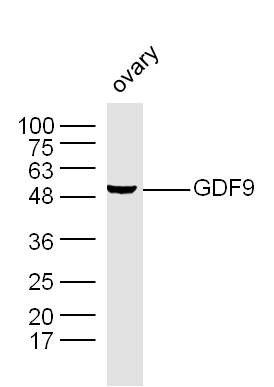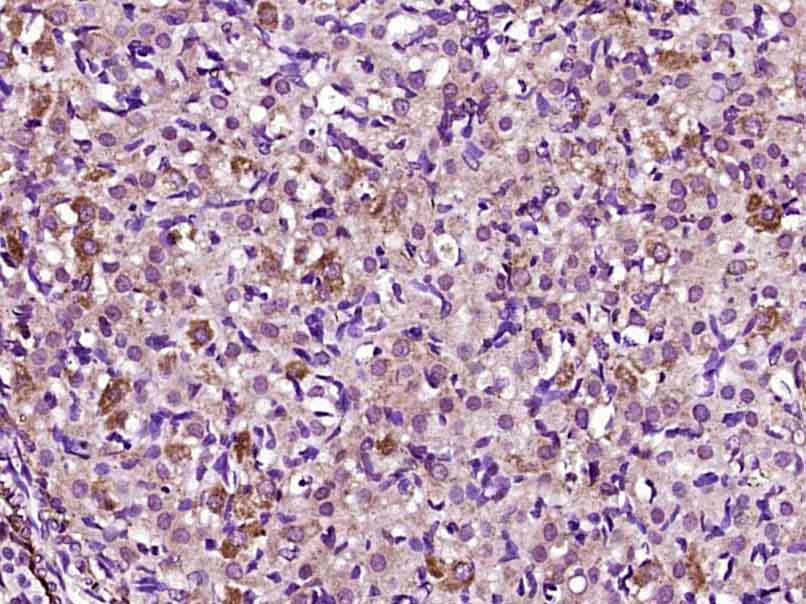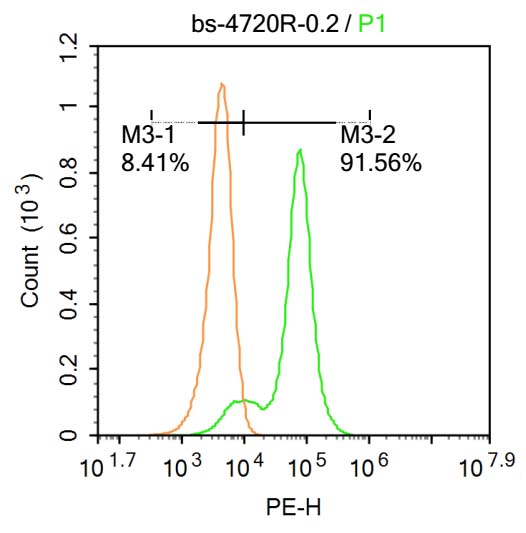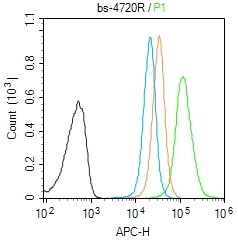
Rabbit Anti-GDF9 antibody
GDF9_HUMAN; GDF9; GDF-9; GDF 9; Growth differentiation factor 9.
View History [Clear]
Details
Product Name GDF9 Chinese Name 生长分化因子9抗体 Alias GDF9_HUMAN; GDF9; GDF-9; GDF 9; Growth differentiation factor 9. literatures Research Area Cardiovascular immunology Signal transduction Stem cells Growth factors and hormones Cell differentiation Immunogen Species Rabbit Clonality Polyclonal React Species Human, Mouse, Rat, (predicted: Chicken, Dog, Pig, Cow, Horse, Sheep, ) Applications WB=1:500-2000 ELISA=1:5000-10000 IHC-P=1:100-500 Flow-Cyt=1ug/Test (Paraffin sections need antigen repair)
not yet tested in other applications.
optimal dilutions/concentrations should be determined by the end user.Theoretical molecular weight 15kDa Cellular localization Secretory protein Form Liquid Concentration 1mg/ml immunogen KLH conjugated synthetic peptide derived from human GDF9: 301-400/454 Lsotype IgG Purification affinity purified by Protein A Buffer Solution 0.01M TBS(pH7.4) with 1% BSA, 0.03% Proclin300 and 50% Glycerol. Storage Shipped at 4℃. Store at -20 °C for one year. Avoid repeated freeze/thaw cycles. Attention This product as supplied is intended for research use only, not for use in human, therapeutic or diagnostic applications. PubMed PubMed Product Detail GDF 9 is a member of the bone morphogenetic protein (BMP) family and the TGF-beta superfamily. This group of proteins is characterized by a polybasic proteolytic processing site which is cleaved to produce a mature protein containing seven conserved cysteine residues. The members of this family are regulators of cell synthesized by ovarian somatic cells directly affect oocyte growth and function. GDF 9 is expressed in oocytes and is thought to be required for ovarian folliculogenesis.
Function:
Required for ovarian folliculogenesis. Promotes primordial follicle development. Stimulates granulosa cell proliferation. Promotes cell transition from G0/G1 to S and G2/M phases, through an increase of CCND1 and CCNE1 expression, and RB1 phosphorylation. It regulates STAR expression and cAMP-dependent progesterone release in granulosa and thecal cells. Attenuates the suppressive effects of activin A on STAR expression and progesterone production by increasing the expression of inhibin B. It suppresses FST and FSTL3 production in granulosa-lutein cells.
Subunit:
Homodimer or heterodimer (Potential). But, in contrast to other members of this family, cannot be disulfide-linked (By similarity).
Subcellular Location:
Secreted (By similarity).
Tissue Specificity:
Expressed in ovarian granulosa cells. Present in oocytes of primary follicles (at protein level).
Post-translational modifications:
Phosphorylated; phosphorylation is critical for GDF9 function. In vitro, can be phosphorylated by CK at Ser-325.
DISEASE:
Note=Altered GDF9 function may be involved in ovarian disorders. Rare variants in GDF9 have been found in patients with premature ovarian failure and mothers of dizygotic twins.
Similarity:
Belongs to the TGF-beta family.
SWISS:
O60383
Gene ID:
2661
Database links:Entrez Gene: 2661 Human
Entrez Gene: 14566 Mouse
Omim: 601918 Human
SwissProt: O60383 Human
SwissProt: Q07105 Mouse
Unigene: 25022 Human
Unigene: 490461 Mouse
Unigene: 9714 Mouse
Unigene: 42874 Rat
GDF9属于转移生长因子–β(TGF-β)及骨形态发生蛋白(BMP)家族成员。Product Picture
Primary: Anti-GDF9 (SL4720R) at 1/300 dilution
Secondary: IRDye800CW Goat Anti-Rabbit IgG at 1/20000 dilution
Predicted band size: 15 kD
Observed band size: 50 kD
Paraformaldehyde-fixed, paraffin embedded (Rat ovarian); Antigen retrieval by boiling in sodium citrate buffer (pH6.0) for 15min; Block endogenous peroxidase by 3% hydrogen peroxide for 20 minutes; Blocking buffer (normal goat serum) at 37°C for 30min; Antibody incubation with (GDF9) Polyclonal Antibody, Unconjugated (SL4720R) at 1:400 overnight at 4°C, followed by operating according to SP Kit(Rabbit) (sp-0023) instructionsand DAB staining.Blank control:Molt-4.
Primary Antibody (green line): Rabbit Anti-GDF9 antibody (SL4720)
Dilution: 0.2μg /10^6 cells;
Isotype Control Antibody (orange line): Rabbit IgG .
Secondary Antibody : Goat anti-rabbit IgG-PE
Dilution: 0.2μg /test.
Protocol
The cells were fixed with 4% PFA (10min at room temperature)and then permeabilized with 0.1% PBST for 20 min at room temperature. The cells were then incubated in 5%BSA to block non-specific protein-protein interactions for 30 min at at room temperature .Cells stained with Primary Antibody for 30 min at room temperature. The secondary antibody used for 40 min at room temperature. Acquisition of 20,000 events was performed.Blank control (Black line): Molt4 (Black).
Primary Antibody (green line):Rabbit Anti-GDF9 antibody (SL4720R)
Dilution: 3μg /10^6 cells;
Isotype Control Antibody (orange line): Rabbit IgG .
Secondary Antibody (white blue line): Goat anti-rabbit IgG-AF647
Dilution: 3μg /test.
Protocol
The cells were fixed with 4% PFA (10min at room temperature)and then permeabilized with PBST for 20 min at room temperature. The cells were then incubated in 5%BSA to block non-specific protein-protein interactions for 30 min at room temperature .Cells stained with Primary Antibody for 30 min at room temperature. The secondary antibody used for 40 min at room temperature. Acquisition of 20,000 events was performed.
Bought notes(bought amounts latest0)
No one bought this product
User Comment(Total0User Comment Num)
- No comment






 +86 571 56623320
+86 571 56623320
 +86 18668110335
+86 18668110335

